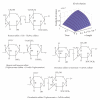Molecular aspects of Plasmodium falciparum Infection during pregnancy
- PMID: 17641725
- PMCID: PMC1906705
- DOI: 10.1155/2007/43785
Molecular aspects of Plasmodium falciparum Infection during pregnancy
Abstract
Cytoadherence of Plasmodium-falciparum-parasitized red blood cells (PRBCs) to host receptors is the key phenomenon in the pathological process of the malaria disease. Some of these interactions can originate poor outcomes responsible for 1 to 3 million annual deaths mostly occurring among children in sub-Saharan Africa. Pregnancy-associated malaria (PAM) represents an important exception of the disease occurring at adulthood in malaria endemic settings. Consequences of this are shared between the mother (maternal anemia) and the baby (low birth weight and infant mortality). Demonstrating that parasites causing PAM express specific variant surface antigens (VSA(PAM)), including the P. falciparum erythrocyte membrane protein 1 (P f EMP1) variant VAR2CSA, that are targets for protective immunity has strengthened the possibility for the development of PAM-specific vaccine. In this paper, we review the molecular basis of malaria pathogenesis attributable to the erythrocyte stages of the parasites, and findings supporting potential anti-PAM vaccine components evidenced in PAM.
Figures



Similar articles
-
Variant surface antigen-specific IgG and protection against clinical consequences of pregnancy-associated Plasmodium falciparum malaria.Lancet. 2004 Jan 24;363(9405):283-9. doi: 10.1016/S0140-6736(03)15386-X. Lancet. 2004. PMID: 14751701
-
VAR2CSA and protective immunity against pregnancy-associated Plasmodium falciparum malaria.Parasitology. 2007;134(Pt 13):1871-6. doi: 10.1017/S0031182007000121. Parasitology. 2007. PMID: 17958922 Review.
-
Human pregnancy-associated malaria-specific B cells target polymorphic, conformational epitopes in VAR2CSA.Mol Microbiol. 2007 Jan;63(2):335-47. doi: 10.1111/j.1365-2958.2006.05503.x. Epub 2006 Dec 14. Mol Microbiol. 2007. PMID: 17176260 Free PMC article.
-
Differential protein expression profiles between Plasmodium falciparum parasites isolated from subjects presenting with pregnancy-associated malaria and uncomplicated malaria in Benin.J Infect Dis. 2013 Dec 15;208(12):1987-97. doi: 10.1093/infdis/jit377. Epub 2013 Jul 30. J Infect Dis. 2013. PMID: 23901091
-
Clinical and parasitological studies on immunity to Plasmodium falciparum malaria in children.Scand J Infect Dis Suppl. 1996;102:1-53. Scand J Infect Dis Suppl. 1996. PMID: 9060051 Review.
Cited by
-
Role of oxidative stress and apoptosis in the placental pathology of Plasmodium berghei infected mice.PLoS One. 2012;7(3):e32694. doi: 10.1371/journal.pone.0032694. Epub 2012 Mar 1. PLoS One. 2012. PMID: 22396790 Free PMC article.
-
Activities of Andrographis paniculata (AS201-01) Tablet on Cox-2 and Prostaglandin Expression of Placental of Plasmodium berghei Infected Mice.Iran J Parasitol. 2021 Jan-Mar;16(1):43-51. doi: 10.18502/ijpa.v16i1.5510. Iran J Parasitol. 2021. PMID: 33786046 Free PMC article.
-
A systematic review and meta-analysis of asymptomatic malaria infection in pregnant women in Sub-Saharan Africa: A challenge for malaria elimination efforts.PLoS One. 2021 Apr 1;16(4):e0248245. doi: 10.1371/journal.pone.0248245. eCollection 2021. PLoS One. 2021. PMID: 33793584 Free PMC article.
-
Plasmodium falciparum population dynamics in a cohort of pregnant women in Senegal.Malar J. 2010 Jun 16;9:165. doi: 10.1186/1475-2875-9-165. Malar J. 2010. PMID: 20553578 Free PMC article.
-
Targeting Plasmodium falciparum Hsp90: Towards Reversing Antimalarial Resistance.Pathogens. 2013 Feb 4;2(1):33-54. doi: 10.3390/pathogens2010033. Pathogens. 2013. PMID: 25436880 Free PMC article. Review.
References
-
- Marsh K, Snow RW. Malaria transmission and morbidity. Parassitologia. 1999;41(1–3):241–246. - PubMed
-
- Chotivanich K, Udomsangpetch R, Simpson JA, et al. Parasite multiplication potential and the severity of falciparum malaria. The Journal of Infectious Diseases. 2000;181(3):1206–1209. - PubMed
-
- Wickramasinghe SN, Abdalla SH. Blood and bone marrow changes in malaria. Bailliere's Best Practice and Research in Clinical Haematology. 2000;13(2):277–299. - PubMed
-
- Chotivanich K, Udomsangpetch R, Dondorp A, et al. The mechanisms of parasite clearance after antimalarial treatment of Plasmodium falciparum malaria. The Journal of Infectious Diseases. 2000;182(2):629–633. - PubMed
-
- Ekvall H. Malaria and anemia. Current Opinion in Hematology. 2003;10(2):108–114. - PubMed
LinkOut - more resources
Full Text Sources
Research Materials
Miscellaneous
